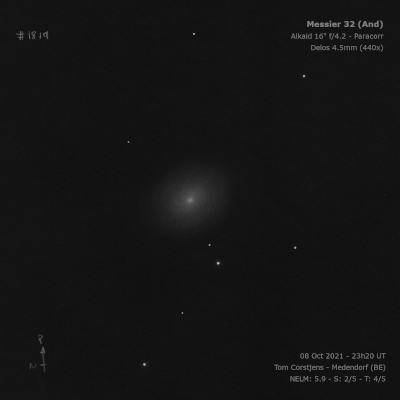
15x50mm (7/26/06): an intense "star-like" core is surrounded by a small halo in my IS binoculars.
Guillaume Le Gentil discovered M32 = NGC 221 = h51 on 29 Oct 1749. He reported "While observing the Andromeda Nebula with a fine 18-foot telescope ... I saw another small nebula, about one minute in diameter which appeared to throw out two small rays; one to the right and the other to the left." Messier found it independently in 1757 while observing M31, unaware of Le Gentil's earlier observation.
In the Appendix to the 1912 'Scientific Papers of Sir William Herschel' this description is given of M32: "1813, December 26, 20 feet telescope, a vB R nebula, vgbM, up to a nucleus." John Herschel recorded (1 Oct 1828), "eB; pL; sbM to a * 10m; 40"; a small star follows it 11.5 seconds."
200/250mm - 8" (8/24/84): very bright, moderately large, round, 24' S of M31.
300/350mm - 13.1" (8/24/84): very bright, moderately large, elongated 4:3 NNW-SSE, about 4'x3', increases to small very bright core which is almost stellar. Located 24' S of the center of M31.
600/800mm - 24" (11/24/14): extremely high surface brightness, large, elongated at least 4:3 NNW-SSE, ~5'x3.5'. The large halo is highly concentrated to a small very bright core. The core itself is sharply concentrated to a very small, very bright nucleus punctuated by an intense stellar nucleus.
Notes by Steve Gottlieb